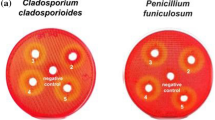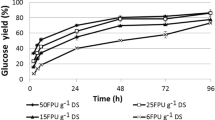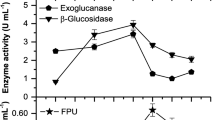Abstract
In this study, the biodegradation of fractionated corn stover in solid-state fermentation by Trichoderma reesei YG3 was investigated. Fractions of miscellaneous cells (MC) and fasciculi (FC) tissue from leaf, shell or core were separated using the combined pretreatment method of carding classification after steam explosion. The highest enzyme activities including the filter paper activity, endoglucanase, exoglucanase and β-glucosidase activities, weight loss rate of dry material and biodegradation rate were all observed in the MC tissue fraction from the leaf, which was more nutritious, while lowest activity was observed in the FC tissue fraction from the shell. The maximum filter paper activity and weight loss rate of the dry material were 4.56 and 1.89 times the minimum and the cellulose and hemicellulose biodegradation rates were 51.22 and 39.38% versus 23.85 and 26.51%, respectively. These variances maybe attributed to the heterogeneity of the component in the fractions. A higher weight loss rate corresponded to higher enzymatic activities, whereas cellulose biodegradation was not proportional to cellulase activities. Hemicellulose biodegradation was much slower than cellulose degradation. Here, we demonstrated the importance of fractionation in component biodegradation and utilization of straw.
Similar content being viewed by others
References
Chen, H. Z. and F. B. Sun (2007) Novel bioconversion of wheat straw to bio-organic fertilizer in a solid-state bioreactor. Biotechnol. Bioproc. Eng. 30: 99–105.
Romero, M., J. Aguado, L. González, and M. Ladero (1999) Cellulase production by Neurospora crassa on wheat straw. Enz. Microb. Technol. 25: 244–250.
Feng, Y., H. Q. Liu, F. Xu, and J. X. Jiang (2011) Enzymatic degradation of steam-pretreated Lespedeza stalk (Lespedeza crytobotrya) by cellulosic-substrate induced cellulases. Biotechnol. Bioproc. Eng. 34: 357–365.
Chen, H. Z. and L. L. Liu (2007) Unpolluted fractionation of wheat straw by steam explosion and ethanol extraction. Bioresour. Technol. 98: 666–676.
Chen, H. Z. and W. H. Qiu (2010) Key technologies for bioethanol production from lignocellulose. Biotechnol. Adv. 28: 556–562.
Li, H. Q. and H. Z. Chen (2008) Detoxification of steamexploded corn straw produced by an industrial-scale reactor. Proc. Biochem. 43: 1447–1451.
Von Sivers, M. and G. Zacchi (1995) A techno-economical comparison of three processes for the production of ethanol from pine. Bioresour. Technol. 51: 43–52.
Panagiotou, G., D. Kekos, B. Macris, and P. Christakopoulos (2003) Production of cellulolytic and xylanolytic enzymes by Fusarium oxysporum grown on corn stover in solid state fermentation. Ind. Crops Prod. 18: 37–45.
Chen, H. Z. and J. Xu (2004) Principle and Application of Modern Solid-state Fermentation. 1st ed., pp. 37–47. Chemical Indus try Press, Beijing, PRC.
Huang, W., H. Niu, Z. S. Li, W. S. Lin, G. H. Gong, and W. Wang (2007) Effect of ellagitannin acyl hydrolase, xylanase and cellulase on ellagic acid production from cups extract of valonia acorns. Proc. Biochem. 42: 1291–1295.
Ghose, T. (1987) Measurement of cellulase activities. Pure Appl. Chem. 59: 257–268.
Yu, B. and H. Z. Chen (2010) Effect of the ash on enzymatic hydrolysis of steam-exploded rice straw. Bioresour. Technol. 101: 9114–9119.
Robertson, J. and P. Van Soest (1991) Methods for dietary fiber, neutral detergent fiber, and non-starch polysaccharides in relation to animal nutrition. J. Dairy Sci. 74: 3583–3597.
Kubicek, C., R. Messner, F. Gruber, M. Mandels, and E. Kubicek-Pranz (1993) Triggering of cellulase biosynthesis by cellulose in Trichoderma reesei. Involvement of a constitutive, sophorose-inducible, glucose-inhibited beta-diglucoside permease. J. Biol. Chem. 268: 19364–19368.
Zhou, X. H., H. Z. Chen, and Z. H. Li (2003) Experimental observation on cellulosic biodegradation in solid state fermentation. Chin. J. Proc. Eng. 3: 447–452.
Xia, L. M. and X. L. Shen (2004) High-yield cellulase production by Trichoderma reesei ZU-02 on corn cob residue. Bioresour. Technol. 91: 259–262.
Awafo, V., D. Chahal, and B. Simpson (2000) Evaluation of combination treatments of sodium hydroxide and steam explosion for the production of cellulase-systems by two T. reesei mutants under solid-state fermentation conditions. Bioresour. Technol. 73: 235–245.
Sukumaran, R., R. Singhania, G. Mathew, and A. Pandey (2009) Cellulase production using biomass feed stock and its application in lignocellulose saccharification for bio-ethanol production. Renew. Ener. 34: 421–424.
Wen, Z. Y., W. Liao, and S. L. Chen (2005) Production of cellulase/ β-glucosidase by the mixed fungi culture Trichoderma reesei and Aspergillus phoenicis on dairy manure. Proc. Biochem. 40: 3087–3094.
Ghose, T., T. Panda, and V. Bisaria (1985) Effect of culture phasing and mannanase on production of cellulase and hemicellulase by mixed culture of Trichoderma reesei D 1-6 and Aspergillus wentii pt 2804. Biotechnol. Bioeng. 27: 1353–1361.
Dogaris, I., G. Vakontios, E. Kalogeris, D. Mamma, and D. Kekos (2009) Induction of cellulases and hemicellulases from Neurospora crassa under solid-state cultivation for bioconversion of sorghum bagasse into ethanol. Ind. Crops Prod. 29: 404–411.
Dorado, J., G. Almendros, S. Camarero, A. Martínez, T. Vares, and A. Hatakka (1999) Transformation of wheat straw in the course of solid-state fermentation by four ligninolytic basidiomycetes. Enz. Microb. Technol. 25: 605–612.
Griffin, H., J. Sloneker, and G. Inglett (1974) Cellulase production by Trichoderma viride on feedlot waste. Appl. Environ. Microbiol. 27: 1061–1066.
Xu, C. Y., F. Y. Ma, and X. Y. Zhang (2009) Lignocellulose degradation and enzyme production by Irpex lacteus CD2 during solid-state fermentation of corn stover. J. Bioscie. Bioeng. 108: 372–375.
Karunanandaa, K., S. Fales, G. Varga, and D. Royse (1992) Chemical composition and biodegradability of crop residues colonized by white rot fungi. J. Sci. Food Agric. 60: 105–112.
Malherbe, S. and T. Cloete (2002) Lignocellulose biodegradation: Fundamentals and applications. Rev. Env. Sci. Biotechnol. 1: 105–114.
Author information
Authors and Affiliations
Corresponding author
Rights and permissions
About this article
Cite this article
Chen, H., He, Q. & Liu, L. Cellulase production from the corn stover fraction based on the organ and tissue. Biotechnol Bioproc E 16, 867–874 (2011). https://doi.org/10.1007/s12257-011-0171-y
Received:
Revised:
Accepted:
Published:
Issue Date:
DOI: https://doi.org/10.1007/s12257-011-0171-y




